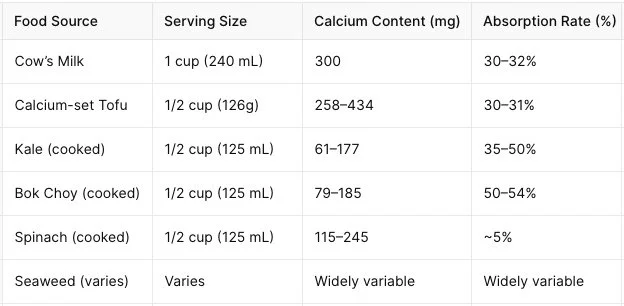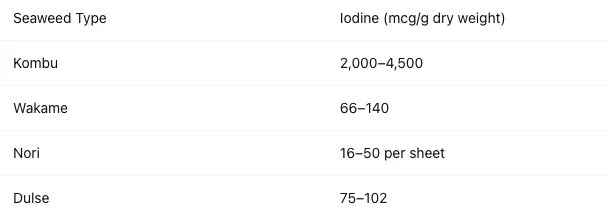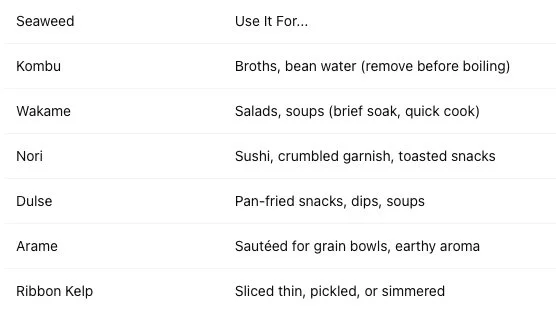Seaweed, Umami, and the Ocean’s Gift to Plant-Based Cooking
Intro: Why Seaweed Deserves a Place on Your Plate
Seaweed isn’t just a sushi wrap or a garnish on miso soup. It’s the ocean’s most overlooked plant—a mineral-rich, umami-packed, and climate-friendly powerhouse. For plant-based eaters, it brings a rare trifecta: deep flavour, dense nutrition, and sustainability.
But it also comes with a learning curve. How do you use it? How much iodine is too much? What about heavy metals?
Let’s explore how to safely, deliciously, and wisely bring seaweed into your meals.
What Makes Seaweed So Savoury? (The Umami Chemistry)
Seaweed is one of the richest natural sources of L-glutamate, the amino acid responsible for umami, the fifth taste. Kombu (Saccharina japonica) can contain over 2,000 mg of glutamate per 100g dried. Other seaweeds like nori, dulse, and wakame also contribute depth and roundness.
Pro Tip: Simmer kombu gently. Avoid boiling, which can turn umami-rich glutamate into bitter compounds.
Umami's Benefits Go Beyond Taste:
Enhances flavour in low-sodium dishes
Increases satiety (helps you feel full)
Supports digestion and gut lining health
It is a precursor to GABA, a calming neurotransmitter
MSG vs Natural Glutamate
The glutamate in seaweed is chemically identical to MSG. Your body processes both in the same way. The key difference is source and context. Many prefer to get their umami from whole foods, but MSG is considered safe by major health agencies when used in moderation.
Seaweed and Bone Health: Not Just About Calcium
Some seaweeds are packed with calcium and magnesium:
Kombu: ~1,970 mg calcium, ~1,120 mg magnesium per 100g dry
Wakame: ~1,760 mg calcium, ~100 mg magnesium per 100g dry
But high content doesn’t equal high absorption. That’s where bioavailability matters:
Pro Tip: Combine seaweed with vitamin C-rich foods (like lemon or capsicum) to boost mineral absorption.
A Whole-Body Approach
Don’t rely on seaweed alone. Bone health requires a nutrient team: Vitamin D, protein, K2, magnesium, phosphorus, zinc, and more.
Should You Take Calcium Supplements?
Some studies suggest calcium supplements may increase cardiovascular risks in certain groups. Others find no consistent link. Whole-food sources of calcium are generally safer and more balanced.
It’s best to get calcium from food and consult a health professional before supplementing.
Bonus: Trace Minerals
Seaweed provides iron, zinc, manganese, chromium, phosphorus, and small amounts of vitamins A, C, K, E, and even B12 (especially in red seaweeds like dulse). It also contains polysaccharides, polyphenols, omega-3s, and other compounds that may support immunity, gut health, and inflammation reduction.
The Iodine Factor: Seaweed's Superpower and Risk
Iodine is essential for thyroid hormone production. Seaweed is the most iodine-rich food on the planet, but that comes with responsibility.
RDA (adults): 150 mcg
Upper Limit: 1,100 mcg (US), 600 mcg (EU)
Just 0.2g of Kombu can exceed safe iodine levels. That’s less than a fingernail.
Excess iodine can lead to hyperthyroidism or hypothyroidism, especially in people with thyroid conditions.
How to Reduce Iodine Safely
Boil kombu and discard the water (reduces iodine by 80–90%)
Soak or rinse in fresh water (also reduces other minerals and flavour)
Remove kombu before boiling to extract umami without excess iodine
Pro Tip: Start with lower-iodine seaweeds like nori or dulse if you're new to sea vegetables.
Know Your Source
Iodine content varies by species, growing region, season, and processing method. Always read labels or ask brands for test results.
If you have thyroid issues, consult your doctor before regularly eating seaweed.
Heavy Metals: What You Need to Know
Seaweed can absorb arsenic, mercury, and lead from polluted waters. This is especially true of seaweed grown for bioremediation (used to clean toxins).
Safe Consumption Tips
Buy from reputable brands that test for contaminants
Look for third-party certifications or inorganic arsenic testing
Avoid hijiki, which is known for high inorganic arsenic levels
Pro Tip: Organic arsenic is less harmful. Inorganic arsenic is the real concern. Ask brands if they differentiate in testing.
Seaweed as a Sustainability Superstar
Seaweed is one of the most sustainable foods on Earth:
No land, fertiliser, or freshwater needed
Captures carbon and reduces ocean acidification
Restores marine biodiversity
Absorbs nitrogen and phosphorus runoff
It’s a blue carbon champion—essential in the fight against climate change.
Beyond Food:
Bioplastics
Fertilisers
Livestock feed (reduces methane emissions)
The challenge? High production costs, complex regulations, and consumer unfamiliarity. But its potential is immense.
Cooking With Confidence: Seaweed by Type
Pro Tip: Blend soaked dulse or wakame with silken tofu, lemon juice, and garlic for a creamy, calcium-packed, umami-rich dip.
Final Takeaway
Seaweed is more than sea lettuce. It’s a bridge between flavour, nutrition, and ecological renewal.
Start small. Choose wisely. Enjoy fully.
Let the ocean nourish you—mindfully. 🌊✨
Disclaimer:
This article is for general information only and not a substitute for professional medical advice. Always consult your doctor or a registered dietitian before making major dietary changes, especially if you have thyroid or kidney conditions.




